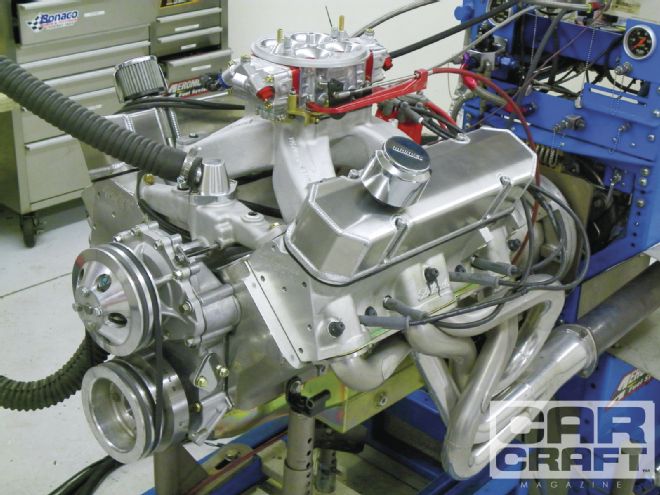
Sometimes you just have to go all out. Ken Crocie of H-O Racing has been building big-block Pontiac engines for close to 40 years, most of which have been aimed at the street, as is this engine. While front-end weight is a concern in drag racing, it's much more critical when turning corners. Today, the most popular ploy when building a road car is to use an enhanced, all-aluminum LS engine. Crocie's customer wanted to keep his '78 Trans Am purely Pontiac by building a big--no, make that very big--all aluminum Pontiac block engine. Big in this case refers to a 4.50-inch stroke and 4.35-inch bore motor that displaces a whacking 535 inches. But even more comforting than the displacement is the distinct lack of cast iron. This rascal is pure aluminum. Frankly, if an aluminum crank could survive the rigors of 690 lb-ft of twist and 6,000 rpm, Crocie would have bolted one in. Virtually everything else that found its way into or onto this big Indian is aluminum--right down to the connecting rods, rocker arms, and even the carburetor. The payoff to all this alloy happened once Crocie put the engine on the scale. In fact, they had to calibrate it to double check the numbers, as its bantam weight of 415 pounds with a carburetor and a Powermaster starter motor seemed unbelievably light.
So what does it take to build an all-aluminum, big-inch Pontiac engine? Crocie documented the buildup with more than 250 photos we've condensed down to a manageable number to tell the story. When building a custom engine like this, it's not as easy as just bolting all the parts together. What's a little scary is whittling away on a $4,500 block to make everything fit.
Ensuring all the parts play well with each other is also a major concern with an engine like this. Crocie had to notch the cylinder liners at the bottom to clear the connecting rods, drill coolant passage holes in the block deck surface, and clearance the block in several places to be able to spin that long-stroke Scat crank without interference. In addition to the Ross pistons, he also added a 1/16-, 1/16-, 3/16-inch ring set from Total Seal using a standard-tension oil ring set, since this motor will see plenty of track time.
Cam Duration Lift Lobe Separation P8 3318S/3319S HR112 at 0.050 at 1.65:1 Intake lobe 3318 248 0.619 112 Exhaust lobe 3319 254 0.639
In Crocie's case, the goal wasn't as much a hero horsepower number as it was a huge payoff in torque. The engine's large displacement promised massive torque potential, and it did not disappoint. When your pump-gas street engine can churn and burn to the tune of 690 lb-ft of torque at a tractor-like 4,400 rpm, the biggest question becomes one of whether the tires will grip. Horsepower was a winning effort, with a max power of 652 hp at a very manageable 5,400 rpm. Long-arm engines can really tax those pistons if you spin them up too high, but with this beast there's little reason to spin it beyond 5,800 rpm. We dialed in a 3,300-pound car, a manual trans, and 3.42:1 gears into the Quarter Jr. dragstrip simulation program, which estimated 10-flat at 136 mph. Sweet! Just thinking about how this big motor would push us back in the seat at 60 mph in high gear is tantalizing. Where do we sign up for a quick lap?
RPM TQ1 HP1 TQ2 HP2 TQ3 HP3 3,000 578 330 571 326 607 347 3,200 602 367 591 360 632 385 3,400 624 404 613 397 648 419 3,600 652 447 633 434 668 458 3,800 661 478 650 471 676 489 4,000 667 508 658 501 674 513 4,200 684 547 669 535 669 535 4,400 690 578 670 561 660 553 4,600 686 601 667 584 648 567 4,800 680 621 659 603 635 580 5,000 673 641 647 616 619 589 5,200 652 645 629 623 601 595 5,400 635 652 616 634 581 597 5,600 610 651 603 643 559 596 5,800 - - 582 643 530 586 Peak 690 652 671 643 676 597 Averages 651.8 535.4 636.0 521.9 636.1 518.0 *This list is not a complete accounting of all components, but the total cost is accurate.